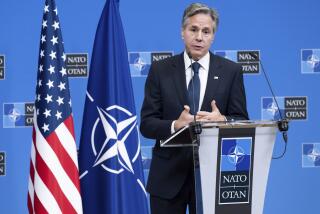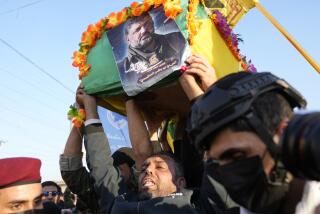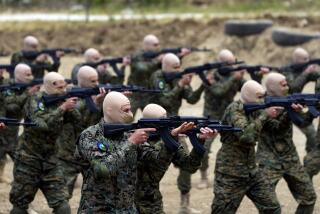U.S. Considers Allying With Afghan Rebels
- Share via
WASHINGTON — As U.S. forces prepare for possible deployment in Central Asia, the Bush administration is considering an alliance with Afghan resistance fighters who might be able to help the U.S. overcome the Taliban and negotiate the region’s perilous terrain.
The group is known as the Northern Alliance, a coalition of anti-Taliban guerrillas headed by the leader of the government driven from power by the Taliban in 1996.
Although it controls as little as 5% of the country, and lost its military commander to assassins last week, some administration officials say that a joint effort could bring tactical military benefits.
Some argue that the Northern Alliance might not be the answer to the search for a new regime to replace the Taliban. Under its previous leadership, violence destroyed much of Kabul, the capital.
But the forces could conceivably provide a wide range of military benefits: intelligence on the Taliban forces and terrorist groups, help with local dialects and communities, and assistance in calling in airstrikes. They might be able to divert Taliban fighters during U.S. attacks and sabotage key government targets.
U.S. forces might also be able to make key use of some of their assets for staging operations, possibly including Baghram air base, 65 miles north of Kabul, which the alliance claims to control.
A senior U.S. official, who asked to remain unidentified, confirmed that the administration is considering some form of alliance with the group. And Hamroon Amin, a coalition spokesman visiting Washington this week, said he was here to discuss the alliance’s offer of help.
The U.S. has relationships with many resistance groups, ranging from the Nicaraguan Contras to the ethnic Albanians in Kosovo and the Iraqi resistance fighters. Some, such as the U.S. ties to the Contras, raised difficult political questions.
But most U.S. analysts say that at the moment, the key question here doesn’t concern politics but the plan’s possible effectiveness.
Although the alliance claims to have about 30,000 fighters, many analysts say the number might be half that. By comparison, the Taliban is believed to have about 50,000, about one-third of whom are engaged at any one time in battling the Northern Alliance.
The alliance has tanks, artillery, armed helicopters and a few aircraft, analysts say. But the Taliban, which has shoulder-fired Stinger missiles and other antiaircraft arms, has often managed to keep their planes from flying.
The Taliban has not seriously threatened the alliance’s strongholds, around the Panjshir Valley in the northeastern corner of Afghanistan. With aid from Russia, India and Iran, the alliance has been able to conduct offensives that have come close to Kabul. And forces associated with it have held territories in the western and central parts of Afghanistan.
Yet despite the skills that alliance forces have shown in their fierce battles with the Taliban, they have not appeared to be close to overthrowing the regime, Western analysts say.
Though the Northern Alliance is recognized by many countries as the legitimate government of Afghanistan, and holds the Afghan seat in the United Nations, it has no real governing structure in the country.
Daniel Benjamin, a National Security Council official in the Clinton administration, said that U.S. officials in the past had chosen not to forge a stronger relationship with the Northern Alliance because they didn’t believe the coalition was strong enough to overthrow the Taliban.
But he said that now “everything’s changed,” and it might be worthwhile to explore whatever the group could offer.
He said there would be limits to any military cooperation because U.S. forces and the alliance don’t share common tactics, or compatible equipment.
Terrence Taylor, assistant director of the London-based International Institute for Strategic Studies, said that with the death of the alliance’s charismatic military commander, it is “difficult to assess their morale and effectiveness.”
The military chief, Ahmed Shah Masoud, who was called the “Lion of Panjshir,” was considered a brilliant tactician and an adept politician. He died last week of wounds he suffered in a bombing by terrorists who posed as a TV news team.
Despite these questions, Taylor said, the group “would be of significant help” to the U.S. He said its members have shown the ability to take the Taliban by surprise and have often carried the battle close to Kabul, forcing the Taliban to move in troops to protect its northern flank.
“They are a force the Taliban has to worry about,” he said.
He said that the U.S. might be wise to keep any alliance covert, and to let the Russians, who have been the group’s principal supplier, continue to take the lead.
Michael O’Hanlon, a defense analyst at Brookings Institution, said the U.S. could try to build up the Northern Alliance in hopes of attracting other anti-Taliban forces in the country.
It could take a year or longer, he said, to strengthen the force with a program of training and equipping. “But you have to hope that things will snowball” and others will join a fight to replace the Taliban, he said.
More to Read
Sign up for Essential California
The most important California stories and recommendations in your inbox every morning.
You may occasionally receive promotional content from the Los Angeles Times.














